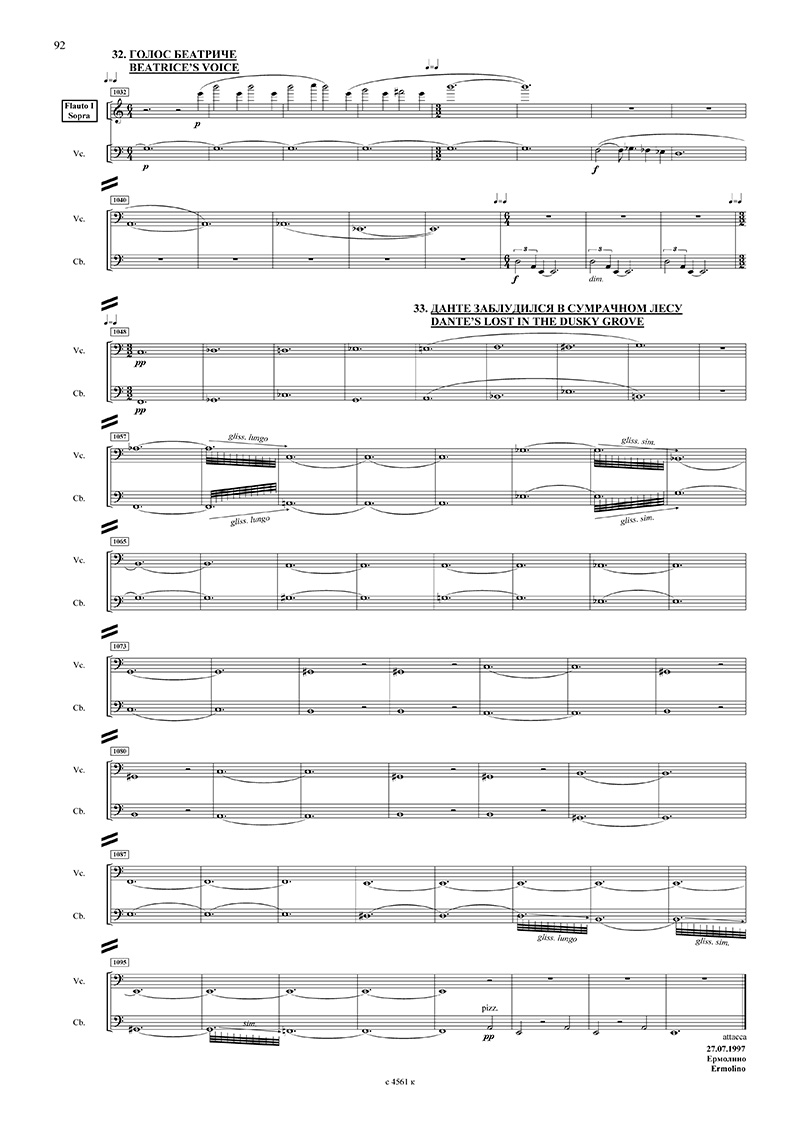
Tishchenko B. Beatrice. Choreo-symphonic cycliade. Dante-symphony № 1 (Among the Living Ones). Score
- Author:
- Tishchenko B.
- Author (full):
- Boris Tishchenko
- Title (full):
- Beatrice. Choreo-symphonic cycliade. Dante-symphony № 1 (Among the Living Ones) for full symphony orchestra. Score
- Number of pages:
- 92
Revising “La Divina Commedia” I used to ask myself the following questions. What was the reason of Dante to have lost Beatrice? What led him to loneliness, banishment and journey to the other world? The answers came to me partially in “The New Life”, partially in the descriptions of Dante’s and his contemporaries’ earthly life scattered all over the “Commedia” and even more in Beatrice’s monologue-reproach addressed to Dante, when she meets him in the other world. (Purgatory, Canto 30). I tried to imagine Dante himself, his life in details, the sequence of events having inspired these eternal lines:
And passing earth existence to the half
I found I was placed in sulky wood…
What could be his nature? He must have been reckless and vulnerable, like many gifted persons, inclined to vivid keen reaction, perceiving everything ardently and insatiably — no matter, the game, or political hippodrome.
There are special sacrament figures of Dante, i. e. 3 and 9, acting symbolically throughout the whole symphony. The starting point is the E — the third key, the inverted triad. 3+3+3, or 3х3=9. Being nine Dante meets Beatrice, who is about nine. The thirds and the nines dominate in the “Commedia’s” structure, sparkling and rising, shrilling all around in the brief introduction like sudden lightening of rhythm and intonation. Further they occur to be inculcated inside the whole substance of the symphony.
Two children meet. Beatrice is the first one to appear, and then Dante comes to the stage. Every personage is given his own thematic material, blissful and adolescent for Beatrice and pensive one for Dante (odd even structures alternate in Dante’s rhythmic). Other teenagers are getting involved to the game. Insatiable Dante can’t help overcoming his passion, thus he escapes with the other youngsters unable to cease playing. Beatrice is left abandoned.
The next time being already a young gentleman Dante meets the young lady Beatrice. Reality invades their world as some fantastic carnival of lads and lassies, engrossing the poet. Beatrice seems more vulnerable about being abandoned. This feeling is expressed by the theme B-E-A-[t]-R-I-C-E of adult Beatrice.
She fades away to non-existence being only 25. Dante mourns her desperately. Here the theme of his maturity is getting formed (D-A-nt-E). However, the high society is ambushing him. Dante heads his adherents (“the white”). He is involved to the political struggle with the accomplices of Pope Bonifacius VIII (“the black”). He is doomed to defeat, banishment and exile deprived of Love, motherland and refuge. Such tragic circumstances stir up this eager for the infernal journey.
The symphony is based on three apexes — the infant, adolescent and mature one.
Boris Tishchenko
- Author
- Tishchenko B.
- Author (full)
- Boris Tishchenko
- Title (full)
- Beatrice. Choreo-symphonic cycliade. Dante-symphony № 1 (Among the Living Ones) for full symphony orchestra. Score
- Number of pages
- 92



